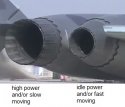You are using an out of date browser. It may not display this or other websites correctly.
You should upgrade or use an alternative browser.
You should upgrade or use an alternative browser.
J-20 5th Generation Fighter VII
- Thread starter siegecrossbow
- Start date
- Status
- Not open for further replies.
Could also just be compensation for local air conditions.If the nozzles have different opening angles, then the same engine output is not set. Are these then flights with simulated engine failure?
They may be using engines as rudders. Especially during landing when speed is low and forces created by rudder are fairly low so they may benefit from extra control authority created by engine steering.
the landing is very demanding as yaw control must be precise so the plane can touch down perfectly straight on the runway if possible.
the landing is very demanding as yaw control must be precise so the plane can touch down perfectly straight on the runway if possible.
Intrepid
Major
Sounds like you've never steered an airplane and don't know the difference in response time between a control surface and a jet engine.They may be using engines as rudders. Especially during landing when speed is low and forces created by rudder are fairly low so they may benefit from extra control authority created by engine steering. The landing is very demanding as yaw control must be precise so the plane can touch down perfectly straight on the runway if possible.
Hyperwarp
Captain
Funny ... I for myself think exactly the other way around: The left one looks like a typical "closed" AL-31, while the other one looks "wider" ... but again; I'm not sure. But after looking again and again I think you are correct.
***
I am beginning to think that both are just AL-31F. Looks a lot like this one -

I cannot say whether they are AL-31F engines. But they are two identical engines.
View attachment 59133
I think from the nozzle alone it is not possible but given the fact the the J-10 uses a special custom-designed variant of the original AL-31F with the gear box relocated to the bottom as the AL-31FN for all J-10s, in mind that the RD-33 was modified to the RD-93 for both the JF-17 and FC-31 again with the gear box relocated to the bottom I cannot believe that CAC decided to use a regular AL-31F with the gear box again relocated on top.
As such I'm quite sure it is an AL-31FN of some sort.
Sounds like you've never steered an airplane and don't know the difference in response time between a control surface and a jet engine.
Not to mention there isn't that much yaw from asymmetric thrust in such closely spaced engines as this.
Most likely training engine-out landings (or, on the ground, using only one throttle to modulate taxi speed because residual thrust at idle is already a large fraction of the power required to keep the aircraft rolling).
The caption is backwards on this image though. As the video shows, the nozzle is fully open at idle and closes with increasing (dry) thrust, to open up again in reheat, according to nozzle pressure ratio.
If the nozzles have different opening angles, then the same engine output is not set. Are these then flights with simulated engine failure?
Yes!
- Status
- Not open for further replies.

